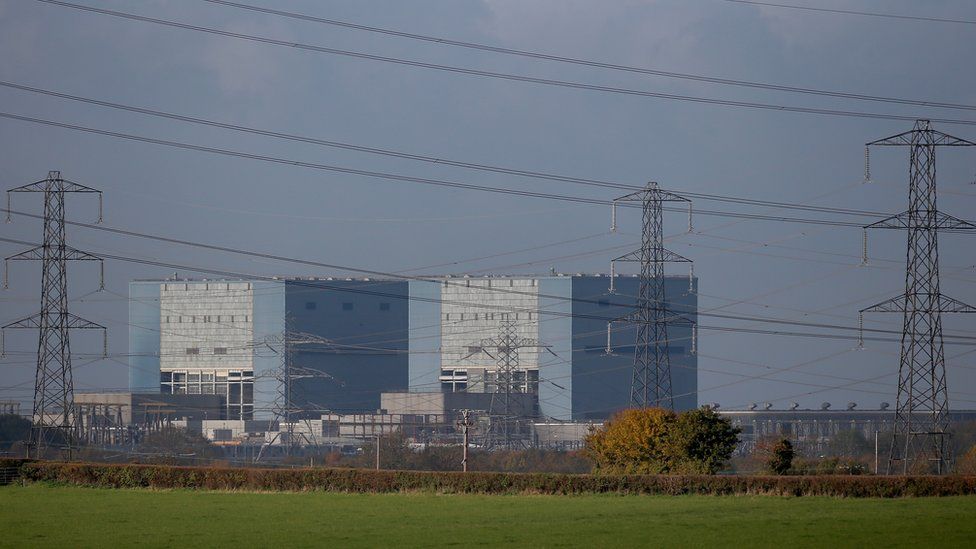Hinkley Point's Cardiff Bay toxic mud claim 'alarmist'
- Published
- comments

Claims that 300,000 tonnes of mud due to be dumped off Cardiff Bay is toxic are "wrong, alarmist and go against all internationally-accepted scientific evidence".
Controversial plans to dispose of mud from the Hinkley Point C nuclear project are being scrutinised by members of the Welsh assembly.
Campaigners want further testing.
But the company behind the project said the mud had been tested "independently to highly conservative standards".
The disposal is needed as part of EDF's £19.6bn Hinkley C power plant building project.
Chris Fayers, EDF's head of environment, said the standards employed were supported by Natural Resouces Wales (NRW), Public Health Wales, the Environment Agency, UK Government and the United Nations.
The mud was "not radioactive" and posed no threat to human health or the environment, he told an assembly committee.
A petition calling for a suspension of the marine licence issued by the Welsh Government in 2013 has received 7,171 signatures.
Meanwhile, another petition by Greenpeace to EDF has been signed by more than 87,000 people.
An open letter has also been presented to Energy Secretary Lesley Griffiths on behalf of a coalition of 10 international ocean conservation charities.
Campaigners fear the mud could have become contaminated by discharges from Hinkley and want a more detailed investigation of samples.
No environmental impact assessment was carried out before permission to dump the sediment at a disposal site, known as Cardiff Grounds, was granted.
It is located just over a mile out to sea from Cardiff Bay.
The Welsh Government insisted it was assessed in line with legal requirements.
Testing on the sediment was carried out by CEFAS, an executive agency of the UK Government, and has since been analysed by NRW.
It found levels of artificial radioactivity in the mud were so low they would equate to being "not radioactive" in law.
A presentation prepared for AMs by EDF outlined a case involving this methodology:
- It "conservatively assumes" a person spends about four hours a day, every day, on the shore near the Cardiff Grounds and eats 50kg of fish and 15kg of crustacean and molluscs a year, all sourced from the Cardiff Grounds
- Exposure to the radioactivity in the sediment is also considered from inhaling any sediment that may accumulate on the shore
- Assuming a person was to do all of the above, 90% of the radiological dose they would receive would be from naturally occurring radiation
The research found combining natural and artificial levels of radioactivity together, any exposure would be 10,000 times less than an airline pilot's annual dose, 750 times less than the average dose received by a resident of Pembrokeshire due to naturally occurring Radon, and equivalent to eating 20 bananas each year - an "infinitesimally small level".
Dr David Richards said radioactivity levels he tested in the Severn Estuary were negligible
Dr David Richards, a reader in physical geography at the University of Bristol has also carried out research on levels of radioactivity in the Severn Estuary.
His samples were taken from salt marshes near the coast at Portishead and Sand Bay. He told BBC Wales the levels of radioactivity he detected were in the "same order of magnitude" as those identified at Hinkley Point.
"At all times it is low, barely above background radiation," he said.
"There's a large amount of sediment involved here, but if you total the amount of radioactivity it is still quite small."
Dr Richards said more needed to be done to improve the public's understanding about radioactivity and what constituted an acceptable dose.
He added: "Most of the radiation that humans receive comes from natural sources that you cannot avoid, or they might be coming from medical sources or transatlantic flights.
"The levels of extra dose that we would be getting from these sediments is minimal, negligible."
Hinkley Point C
Nuclear power station, Somerset
£18bn
building cost
-
25,000 jobs
-
60 year lifespan
-
7% of UK's generation needs
-
£92 per MWh electricity price agreed with UK Government
The results of the most recent testing, carried out in May 2017, are due to be presented to the NRW by the end of the week.
The assembly's petitions committee also heard from campaigners against their plans.
Chris Fayers of EDF and campaigner Tim Deere-Jones, a marine pollution consultant, both gave evidence
Tim Deere-Jones, a marine pollution consultant, who has spearheaded the campaign against the dumping told AMs "we should be extremely cautious of how we dispose of this sediment."
The area where the dredging is due to take place has been in receipt of over half a century's worth of discharges of low-level waste from the former Hinkley Point A and B.
He said the ability of radioactivity to be transferred from sea to land had been well documented and it would be "much better to not run the risk" of moving the mud.
"Don't put it into somebody's inshore waters - we know that inshore waters interact with coastal zones. Leave it where it is."
The petitions committee has already indicated a full debate on the issue may be required in the New Year.
Meanwhile, the chairman of the assembly's environment committee has called for a third party to test samples of the sediment before it is moved.
Writing to NRW, Mike Hedges AM said if concerns around the dumping prove to be unfounded, "a considerable amount of work is needed to translate that message to the public, both locally and more widely".
- Published25 September 2017
- Published15 September 2016
- Published15 September 2016
- Published21 October 2015